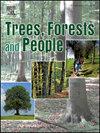干旱胁迫与施肥对红心杉木植株性状及非结构碳水化合物的影响
IF 2.9
Q1 FORESTRY
引用次数: 0
摘要
了解干旱胁迫和施肥对植物生理反应的影响,对于改善气候变化条件下的森林管理具有重要意义。以往的研究主要集中在干旱胁迫对资源分配和死亡率的影响上。然而,施肥和干旱对植物关键性状和非结构性碳水化合物(NSCs)动态的互作效应仍不确定,特别是在红心杉木(Cunninghamia lanceolata (Lamb))中。钩)。本研究通过盆栽试验,研究了不同干旱胁迫梯度和施肥对地上植物性状(不同器官生物量、含水量、针数、针面积)、地下植物性状(主根深度和侧根展布)、叶片水势和NSCs的影响。随着土壤干旱梯度的增大,地上植物和地下植物的生长性状之间的权衡越来越明显。最湿组(W25min)和最干组(W0min)幼树在受精组和未受精组的两个主成分轴上表现出明显的分化,这主要是由枝上叶数和叶片黎明前水势的变化决定的。干旱强度主要影响叶片总NSCs,干旱持续时间主要影响枝条总NSCs。施肥通常会促进植物的生长,尤其是地下组织。干旱期施肥增加了本试验的死亡率,尤其是中度干旱期。研究表明,干旱胁迫梯度和施肥对红心杉木幼树的生长和存活具有拮抗作用,表明干旱与施肥对红心杉木幼树的生长和存活具有拮抗作用。本文章由计算机程序翻译,如有差异,请以英文原文为准。
Impact of drought stress and fertilization on plant traits and nonstructural carbohydrates of Red-Heart Chinese fir
Understanding how drought stress and fertilization influence plant physiological responses is essential for improving forest management under climate change. Previous research has primarily focused on the effects of drought stress on resource allocation and mortality. However, the interaction effect of fertilization and drought on key plant traits and non-structural carbohydrates (NSCs) dynamics remains uncertain, particularly in Red-Heart Chinese fir (Cunninghamia lanceolata (Lamb.) Hook.). In this study, the effects of different drought stress gradients and fertilization on aboveground plant traits (different organ biomass, water content, needle number, needle area), belowground plant traits (tap root depth and lateral root spreads), leaf water potential and NSCs were examined in a pot experiment. The trade-offs in growth between aboveground and belowground plant traits become increasingly evident with soil drought gradients. Saplings in the wettest (W25min) and driest (W0min) group in both fertilized and unfertilized groups show clear differentiation along the two principal component axes, which are primarily determined by variations in the number of leaves on branches and leaf predawn water potential. Drought intensity mainly influences the leaf total NSCs, and the drought duration mainly influences the branch total NSCs. Fertilization typically promotes the growth of plants, especially below ground tissues. However, fertilization during drought exacerbated mortality in our experiment, especially for the moderate drought. The work highlights that Red-heart Chinese fir traits respond to drought stress gradients and fertilization, demonstrates that fertilization in combination with drought has an antagonistic effect on the growth and survival of red-heart Chinese fir saplings.
求助全文
通过发布文献求助,成功后即可免费获取论文全文。
去求助
来源期刊

Trees, Forests and People
Economics, Econometrics and Finance-Economics, Econometrics and Finance (miscellaneous)
CiteScore
4.30
自引率
7.40%
发文量
172
审稿时长
56 days
 求助内容:
求助内容: 应助结果提醒方式:
应助结果提醒方式:


